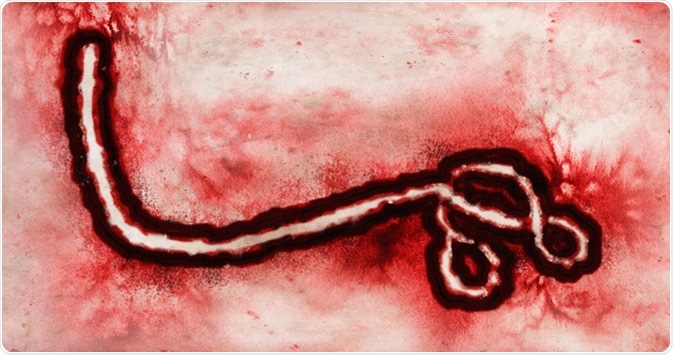Ebola hemorrhagic fever is considered a classic zoonotic disease with the persistence of the Ebola virus in a reservoir species.

Image Credit: Valeniker / Shutterstock.com
The exact source of Ebola infections remains an open question, and despite all the efforts, there remains a lack of clear indicators about the reservoir of the virus. As each country must strengthen its preparedness and response system to prevent eventual Ebola outbreaks in the future, adequate knowledge about the ecology and transmission of this disease is of the uttermost importance.
Animal hosts and reservoir species
Although a considerable amount of effort has been put into identifying the natural reservoirs with every large outbreak of the disease, potential hosts or arthropod vectors for the Ebola virus have not been found. Apes, humans, and possibly other mammalian species susceptible to Ebola infection are regarded as the end hosts, and not as the reservoirs of infection.
Bats and rodents have been considered as potential reservoir species for a long time. Such an idea was supported by experimental studies in African plants and animals that resulted in the transmission of the Zaire Ebola virus to African fruit and insectivorous bats, although a conclusive link could not be established. Unfortunately, aside from the Zaire ebolavirus, there is currently no data on the potential reservoirs of the other four Ebola virus species.
The presence of the Zaire ebolavirus in naturally infected fruit bats was first documented when viral RNA and antibodies were detected in three different bat species of the Pteropodidae family: Hypsignathus monstrosus, Epomops franqueti, and Myonycteris torquata. As a result, there is an overlap of geographic Ebola virus distribution with the range of the fruit bats, although the Zaire ebolavirus has not been successfully isolated from naturally infected animals.
Still, successful isolation of the Marburg virus from the cave-dwelling species of the fruit bat Rousettus aegyptiacus lends support to the proposed idea of bats as a reservoir species for all filoviruses. This idea is further corroborated by Marburg virus outbreaks that have been associated with caves or mines heavily infested with bats.
Reservoir species to end hosts
Transmission of Ebola from the reservoir species to humans or other potential end hosts might be an infrequent event, taking into account the restricted distribution and scarce contact with the reservoir species. However, bats are frequent residents in equatorial Africa, where they are even hunted for food.
As the Ebola virus in the reservoir might present in a subclinical or asymptomatic way, there is a possibility of sporadic activation via appropriate stimuli such as stress, changes in food patterns, or infection with other pathogens, which has been demonstrated in experimental conditions. This could explain the sporadic nature of infection and periodical outbreaks of this disease in Africa.
Non-human primates represent a source of infection for humans, but they are considered an accidental host (akin to humans) and not a reservoir of infection. Ebola outbreaks with the Zaire and Taï Forest ebolaviruses have been observed in gorillas and chimpanzees since 1994. The Reston ebolavirus is dangerous for crab-eating macaque (cynomolgus) monkeys, which were farmed in the Philippines and subsequently imported into the United States and Italy.
Although the latter species was also a suspected cause of a deadly outbreak in pigs in the People's Republic of China and the Philippines, experiments have shown that it does not cause disease in porcine populations. Still, pigs can act as an amplifying host, thus potential transmission routes need to be further addressed.
Ebola - Transmission, Symptoms, Diagnosis, and Treatment
Transmission of the Ebola virus
Infection with the Ebola virus in Africa has occurred through the handling of infected gorillas, chimpanzees, monkeys, fruit bats, forest antelopes, and porcupines. The disease is introduced into the human population via close contact with the blood, bodily secretions, organs, or other fluids of infected animals. Once in humans, Ebola can spread efficiently in the community through human-to-human transmission.
Most human infections during outbreaks usually occur by direct contact with infected patients or cadavers. Healthcare workers, family, and friends in close contact with the diseased are at the highest risk of getting infected, due to close contact with blood or other bodily fluids. Characteristic burial ceremonies where mourners have direct contact with the body of the deceased can also represent an important path of transmission.
The virus enters the host through mucous membranes, breaks, cuts, and abrasions in the skin, or by parenteral introduction. Viral RNA and even infectious particles have been found in the genital secretions, semen, urine, saliva, feces, vomit, and in the skin of infected patients. Various objects (for example needles and syringes) contaminated with infected bodily fluids represent a threat as well; therefore, they should be properly sterilized.
It is important to note that the airborne transmission of Ebola has not been documented, which is comparable to how other respiratory viruses such as the severe acute respiratory coronavirus 2 (SARS-CoV-2) are spread. Although the virus is not transmitted via food or water, and the proper cooking of foods should inactivate infectious particles, ingestion of contaminated food may represent a possible route of exposure in natural infections.
References
Last Updated: Mar 28, 2021